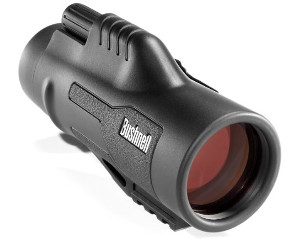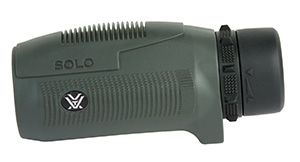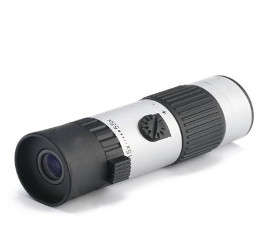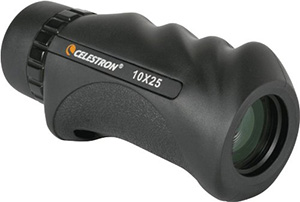Best Monocular For The Money – 2019 Top 5 Ranking
If you’re in the market for a monocular, you’re in good company. Monos are great for scouting terrain, viewing landscape, and watching birds. When you’re ready to make that final purchase, though, you should look around, check prices, and most importantly, read reviews to find out which models are the best and which aren’t worth the time it takes to unbox them. We handle that research for you, and provide you with clear, comprehensive reviews of each model we can get our hands on. First, let’s see which ones make our Top 5 best Monoculars for the money list. Alternatively, you can take a look at our spotting scopes rankings or best rangefinder pages.
Our Top 5 Monocular Picks:
| Model | Magnification | Objective Diameter | Field of View | Length |
|---|---|---|---|---|
Bushnell Legend Ultra HD Check Today's Price | 10x | 42mm | 340 feet @ 1000 yards Our Review | 5.4" |
Vortex Optics Solo Check Today's Price | 10x | 25mm | 315 feet @ 1000 yards Our Review | 4.4" |
Polaris Explorer Check Today's Price | 12x | 50mm | 246 feet @ 1000 yards Our Review | 3.1" |
HDE Compact Monocular Check Today's Price | 15x | 55mm | 150 feet @ 1000 yards Our Review | 4.25" |
Celestron Nature Check Today's Price | 10x | 25mm | 304 feet @ 1000 yards Our Review | 6" |
Best Choice on a Budget:
If you’re looking for a simple, inexpensive monocular, the Best Budget Model we’ve seen is the HDE 15–55 Zoom 21mm. You won’t get the best image quality out of this budget model, but it is a terrific, durable stocking stuffer for casual use by kids or amateur wildlife enthusiasts.
Best Overall:
On the other hand, if you want the finest mono that money can buy, the Best Top of the Line model would have to be the Bushnell Legend Ultra HD. The Legend Ultra HD provides a fantastic image, is tripod-compatible, and has a Picatinny rail for attaching accessories. Magnification is a crisp and clear 10X, perfect for any long-range use like hunting, wildlife viewing, or casual stargazing.
Now that you know which ones we consider the best, let’s take a look at what you should be examining when you are trying to decide which mono to buy and which one to pass up.
What Comes With It?
You should first look at what you get for your money. Monoculars need a place to live when you aren’t using them, so you should expect to receive a carrying case to go along with your purchase. You should also look for one that includes a neck lanyard/strap or hand strap, so you have some way to keep a grip on the case when you have it at the ready. Finally, a nice bonus is a lens cleaning cloth to keep the monocular clean enough for a clear picture.
How Powerful Is It?
As a next step, you should look at how much magnification the monocular will give you. You want to be able to see things far away, but you should also know that there is a fine line between just enough magnification and too much magnification to be useful. For example, an extremely small mono with 10X magnification may sound nice, but it’s exceptionally hard to hold it still, no matter how good the manufacturer is. If you want a compact instrument, you are probably going to be better off with 6X or 8X, unless you look for one that includes a tripod mount (and you to use a tripod).
What Type of Optics Does It Use?
After magnification, but equally important, you should look at the quality of the optics. For best view of your subjects, you want the optics to provide a clear, crisp, bright view at maximum magnification. This depends greatly on how well the optics are manufactured and treated. You’ll want to make sure the optics use the best possible prism glass, BaK–4 glass, and that the optics are fully multi-coated. This ensures an excellent image and maximum light transmission.
A few larger monoculars may use porro prism layouts instead of roof prisms, but the quality of roof prisms and the accompanying lenses have progressed to the point where it really does not matter which of the two you have. In fact, the tendency of porro prism optics to become very blurry after slight bumps might make a roof prism setup preferable for you.
You’ll also want to know about the field of view from the monocular. Some mono’s offer such a narrow field of view that the shakiness of your hands can make the optic impossible to use without mounting it on a tripod. A healthy field of view is also important for getting the most view out of your monoc.
Finally, make sure the model has a focus ring that will suit your particular uses. If you are tracking birds, for example, you’ll want a focus ring that moves just easily enough that you can make quick adjustments, but not so easily that you can inadvertently bump an image out of focus. On the other hand, if you mostly view stationary objects, you might prefer a very stiff focus ring that is next to impossible to accidentally move.
What’s the Body Made Of?
After you know about the inner workings of the monocular, you should pay special attention to the body / casing. Is it rubber coated for durability? Does it provide an ergonomically comfortable grip for easy use? Does the housing provide a lanyard hole? These are all important questions to ask, because this is something that you will be using heavily in the field, and you want it to be durable and also easy to hold and handle.
How Durable Is It?
Speaking of durability, you’ll want to closely examine it inside and out. You’ll want to know whether or not the monocular is waterproof and/or shockproof, and whether or not the chamber of the optics is nitrogen-filled to prevent fogging. It might also be useful to know about the warranty, since some high end models can provide fantastic warranties that even give you your full purchase price back if you are not totally satisfied with your purchase.
The material the mono is made of is extremely important for determining durability. In general, you should avoid anything that is constructed of plastic, unless you are buying it as a gift for a child or someone you don’t really like 😉
How Well Does It Perform in Real Life Use?
All of the technical details are great, but nothing beats knowing how well a monocular performs in real-world conditions. Read reviews carefully to see how the reviewer used the equipment. If you’re a hunter, your needs are going to be vastly different from a birdwatcher, so you will want to look for a review that discusses how well the mono fares on hunting trips. Likewise, a hiker or casual stargazer might look for something completely different, so evaluate what uses you might have for the monocular and make sure you read reviews that cover as many of those uses as possible.
Sometimes, you might just want to get a little bit of a better look at something while you’re traveling, so a monocular that is mentioned as being good for casual use might be right up your alley. After all, maybe you want to keep an inexpensive one in the car with you while also having a better model for your hiking or hunting trips. Look for value models that are good for that purpose, and you can save yourself some money while still getting what you need out of the optical instrument.
Wrapping It Up
Every time we review a mono, we provide a summary that wraps up its best and worst features. This is your chance to get a last and final impression of the instrument, and whether or not it might suit your needs. Every monocular is different, and we try to provide you with as much information as possible about it before we finish up our review.
By doing some of research, you can readily find a model that is suitable for any purpose, whether it’s nature-viewing, hunting, or casual stargazing. Be sure to read every review you find with an eye for what you plan to use the instrument for, so you can be the best informed when you make your purchasing decision.








